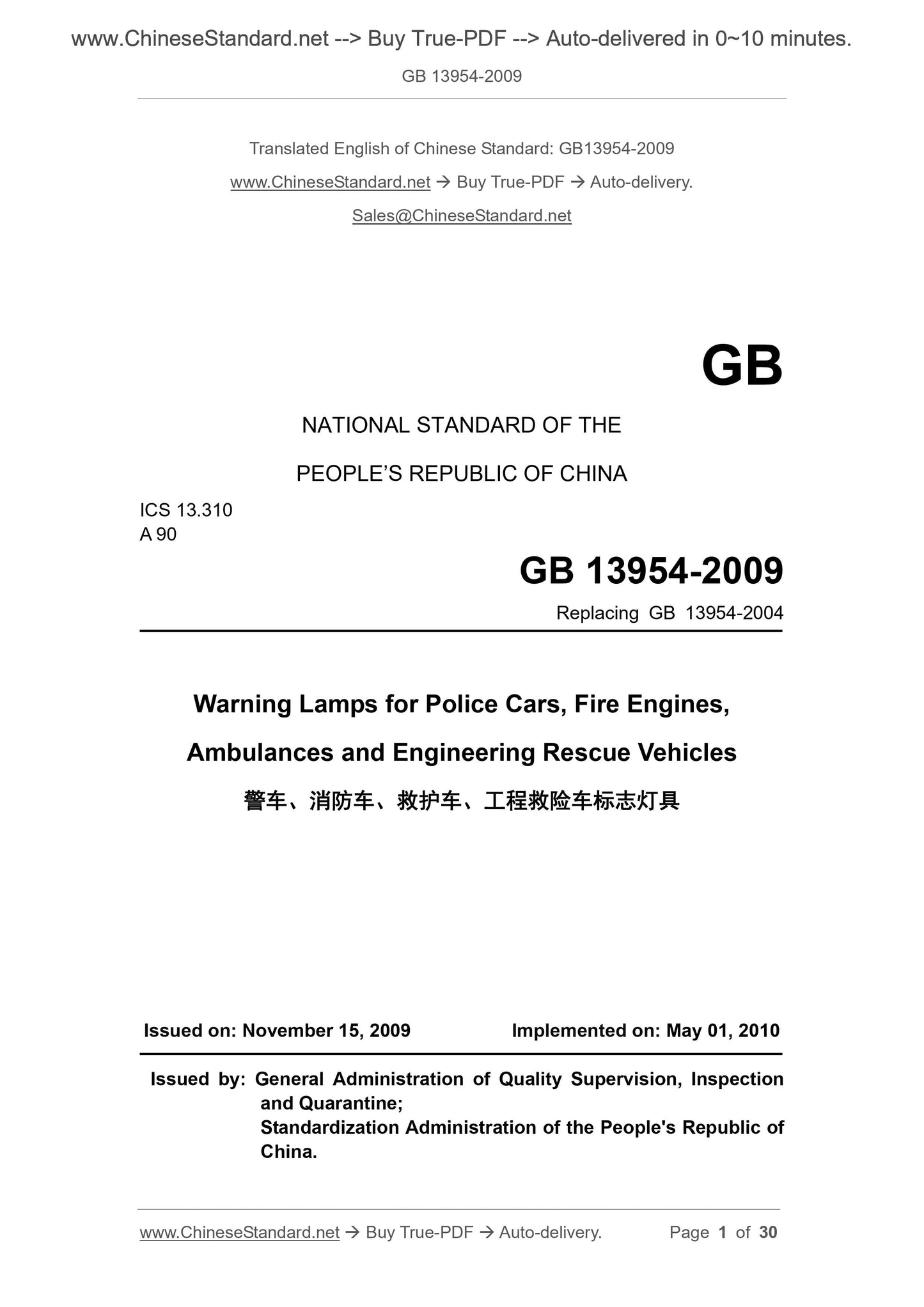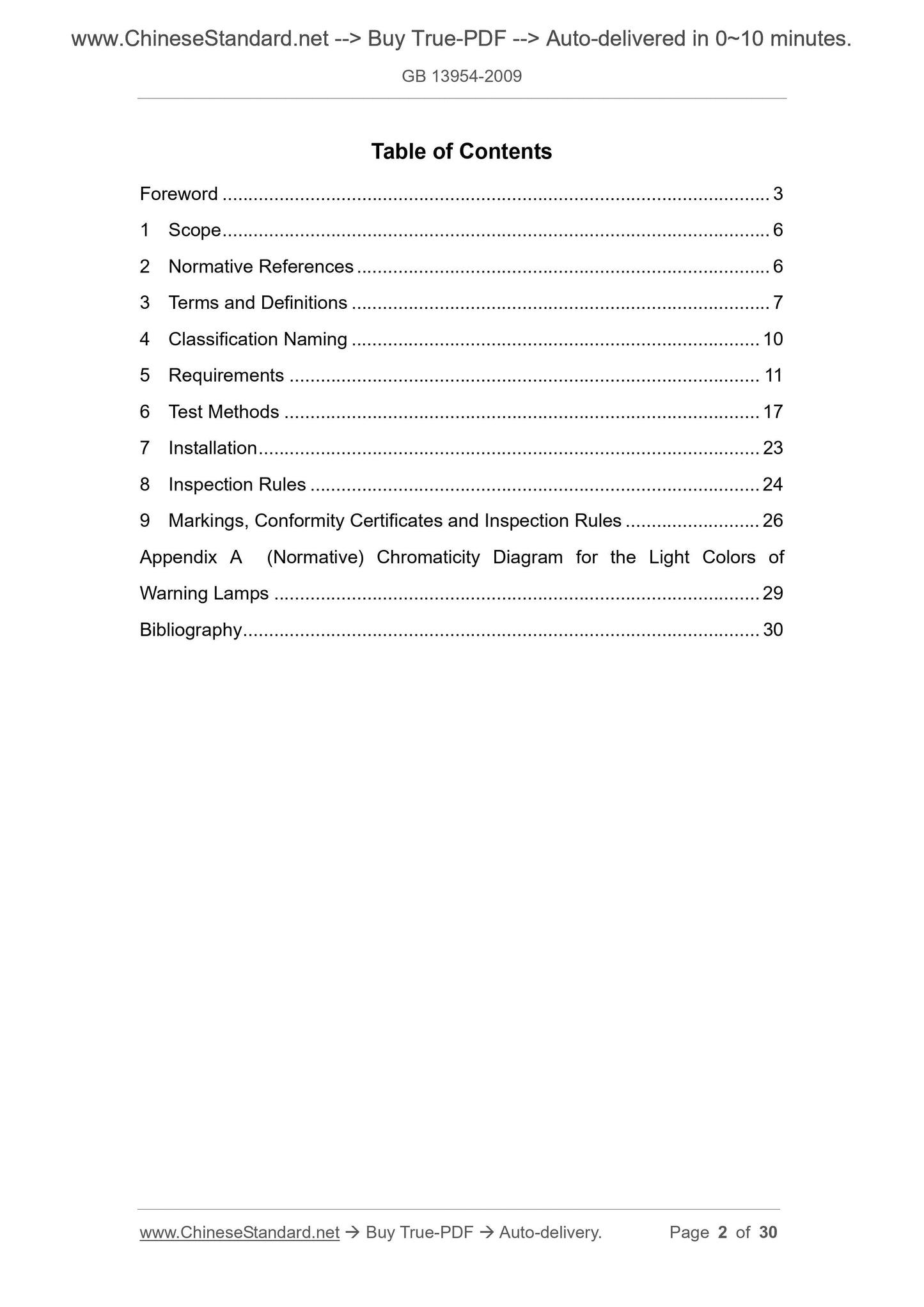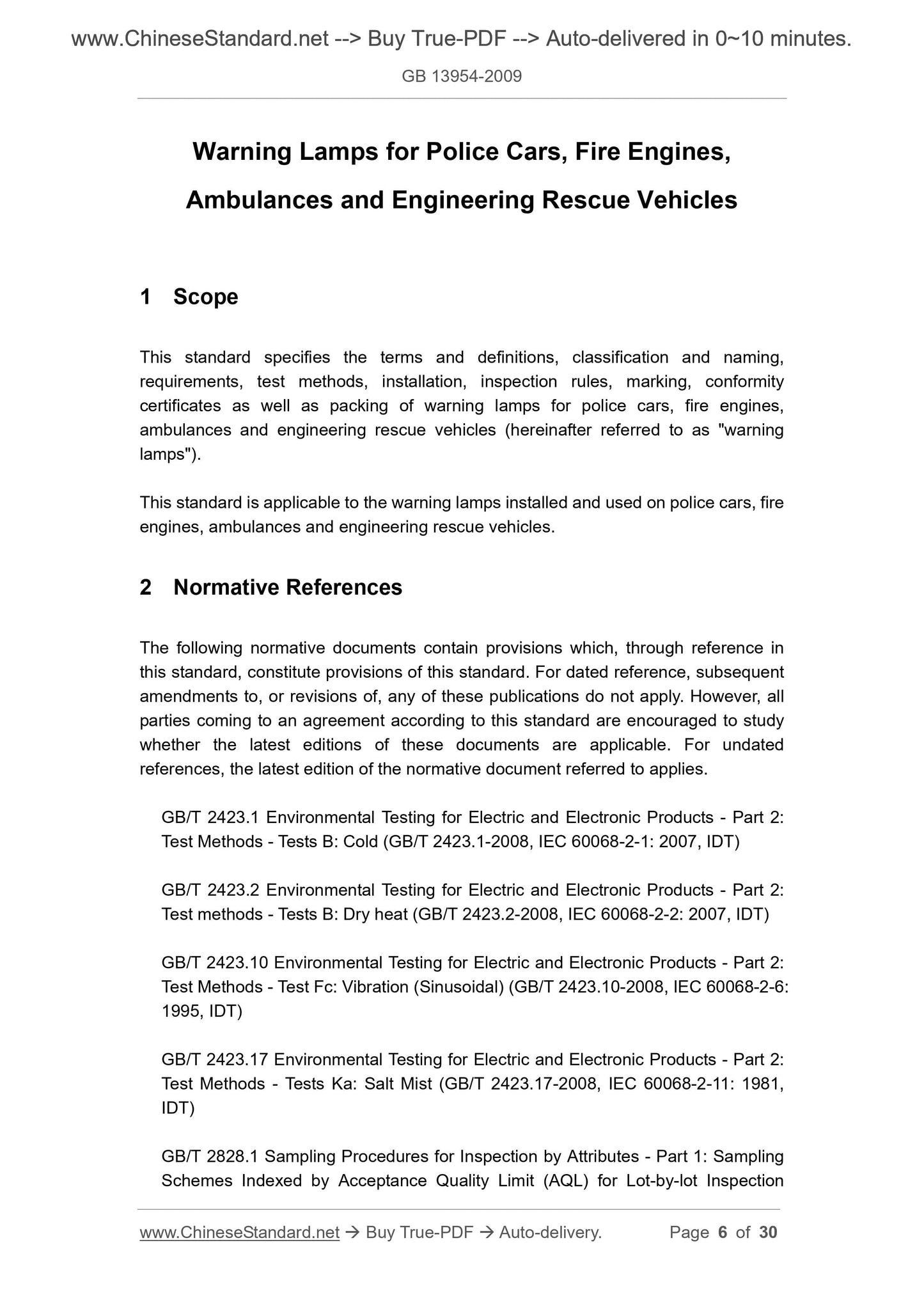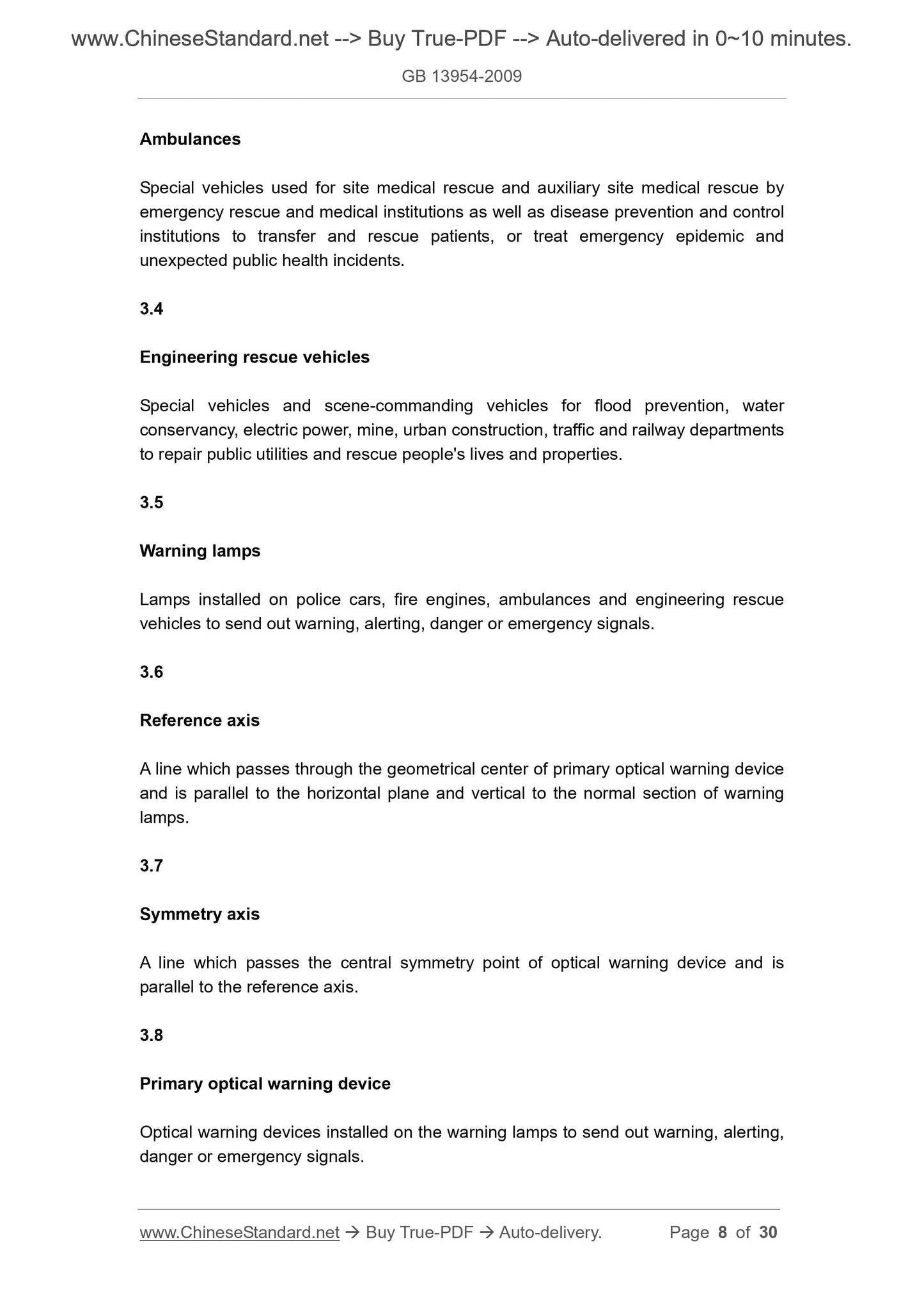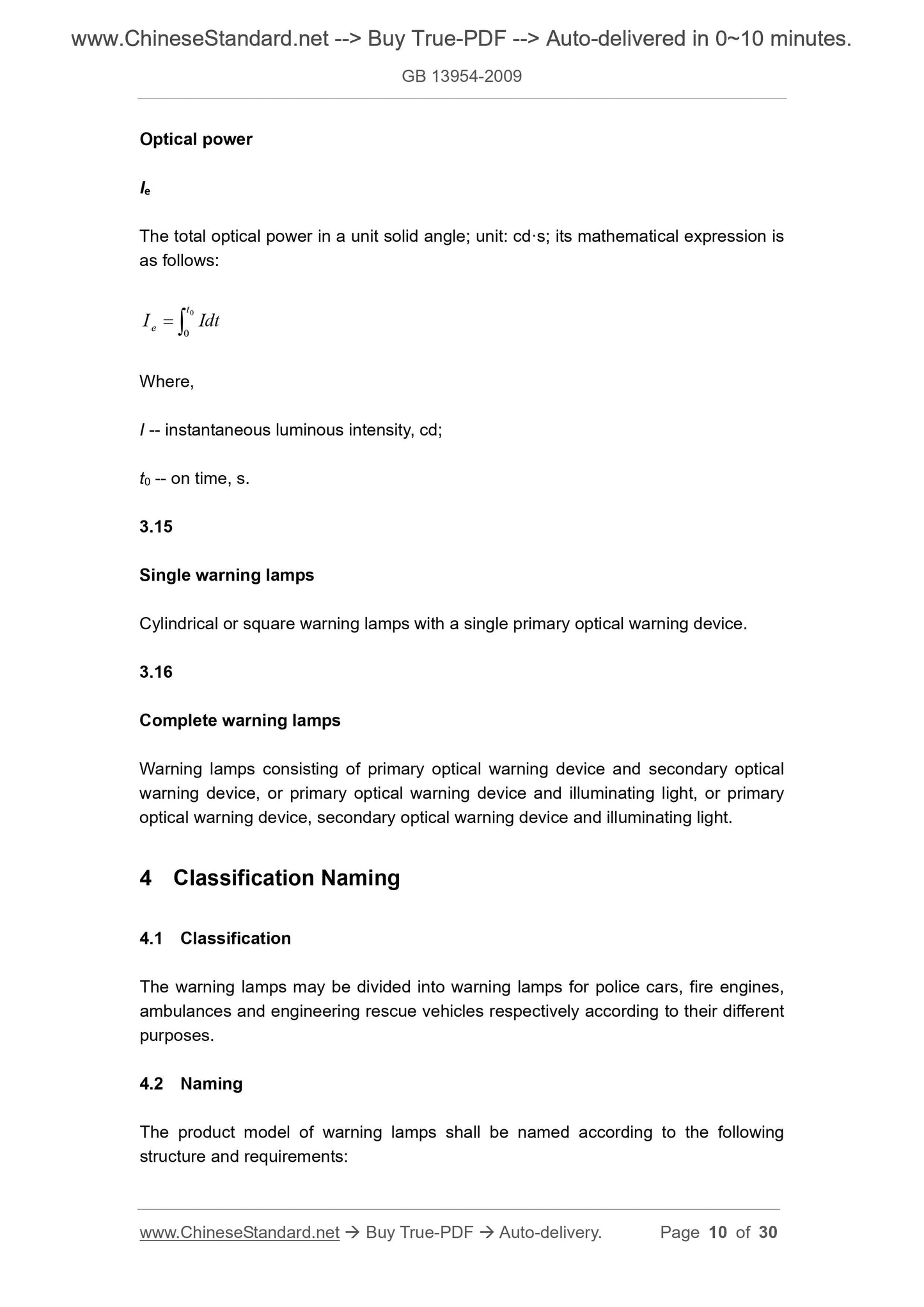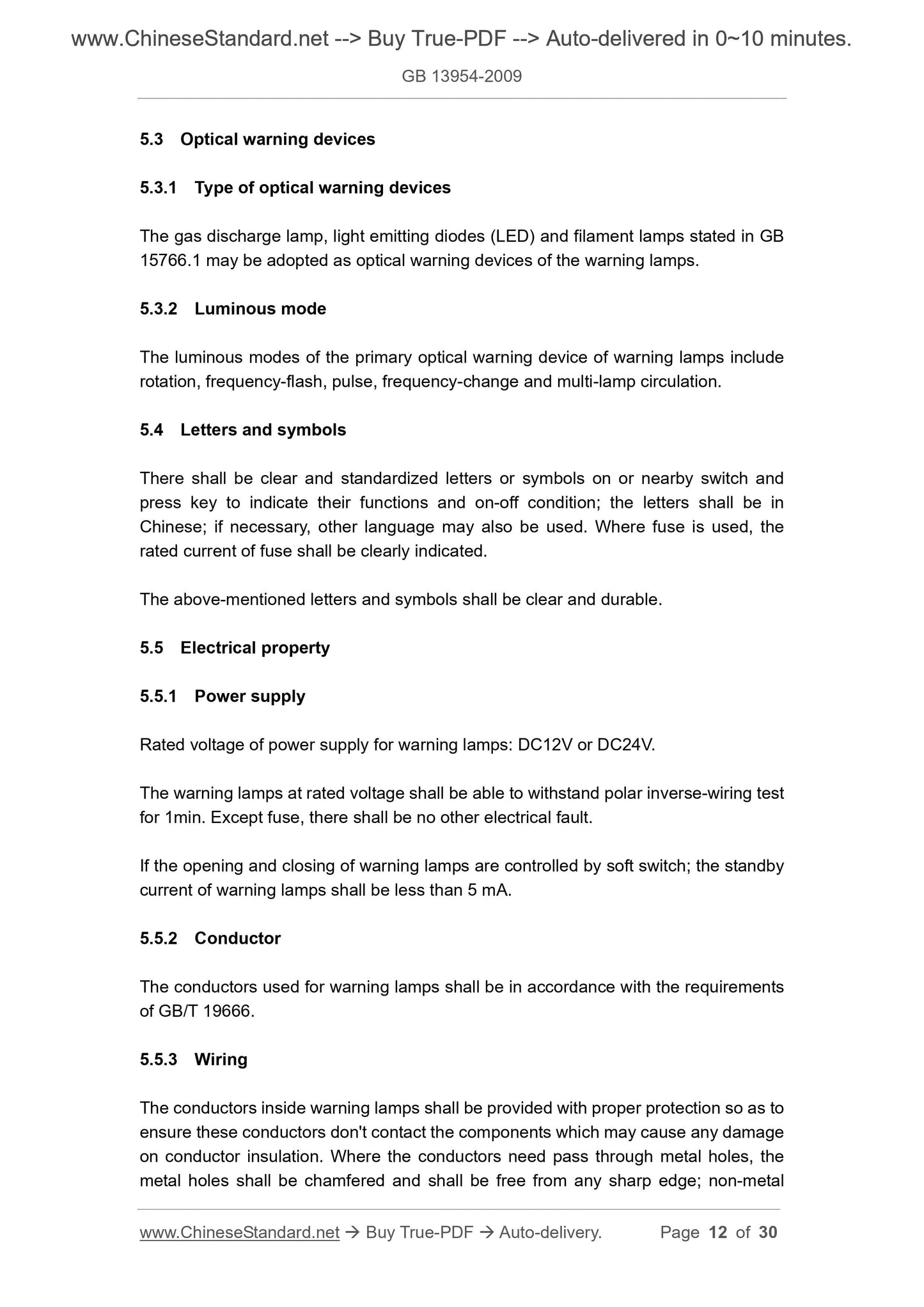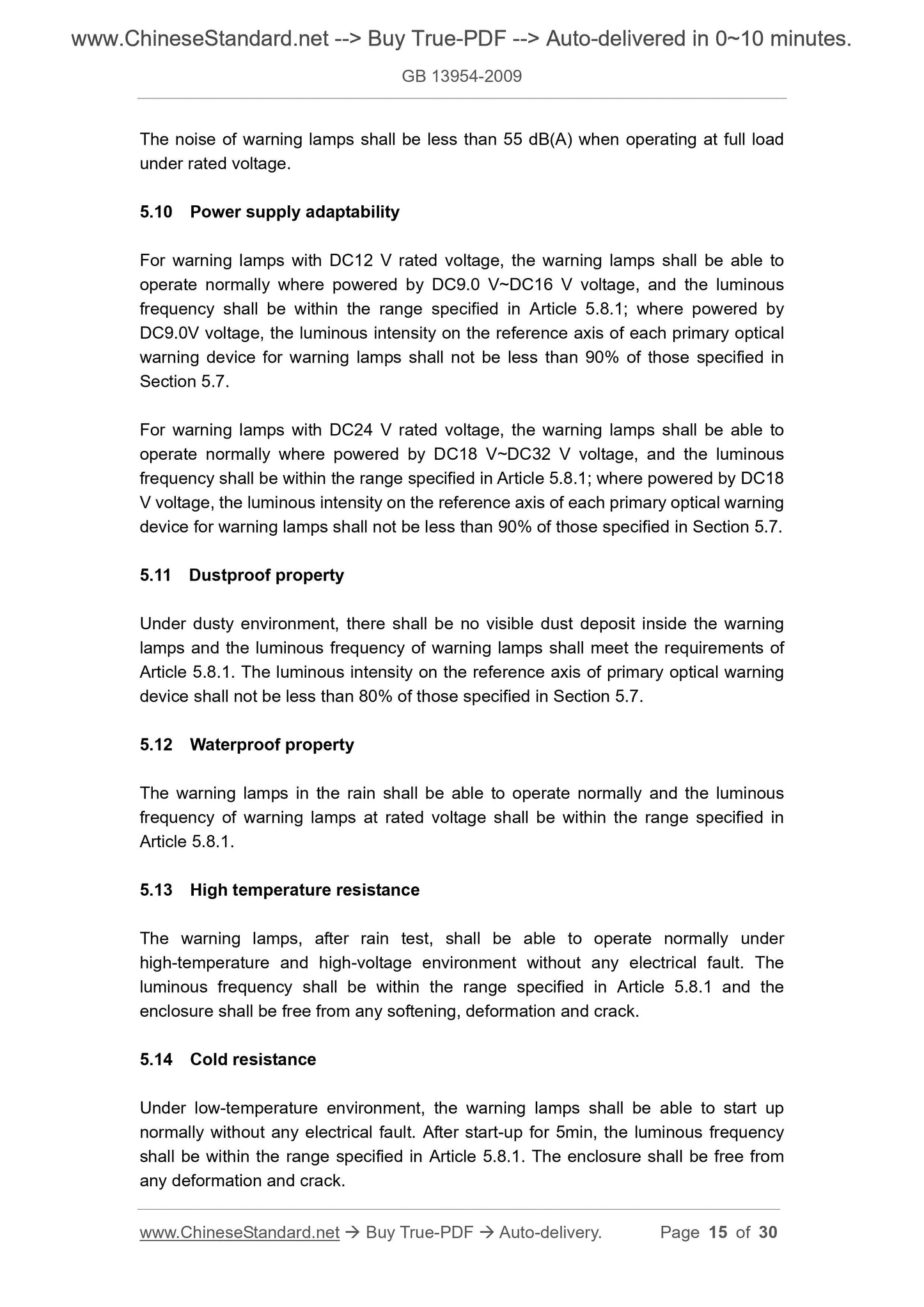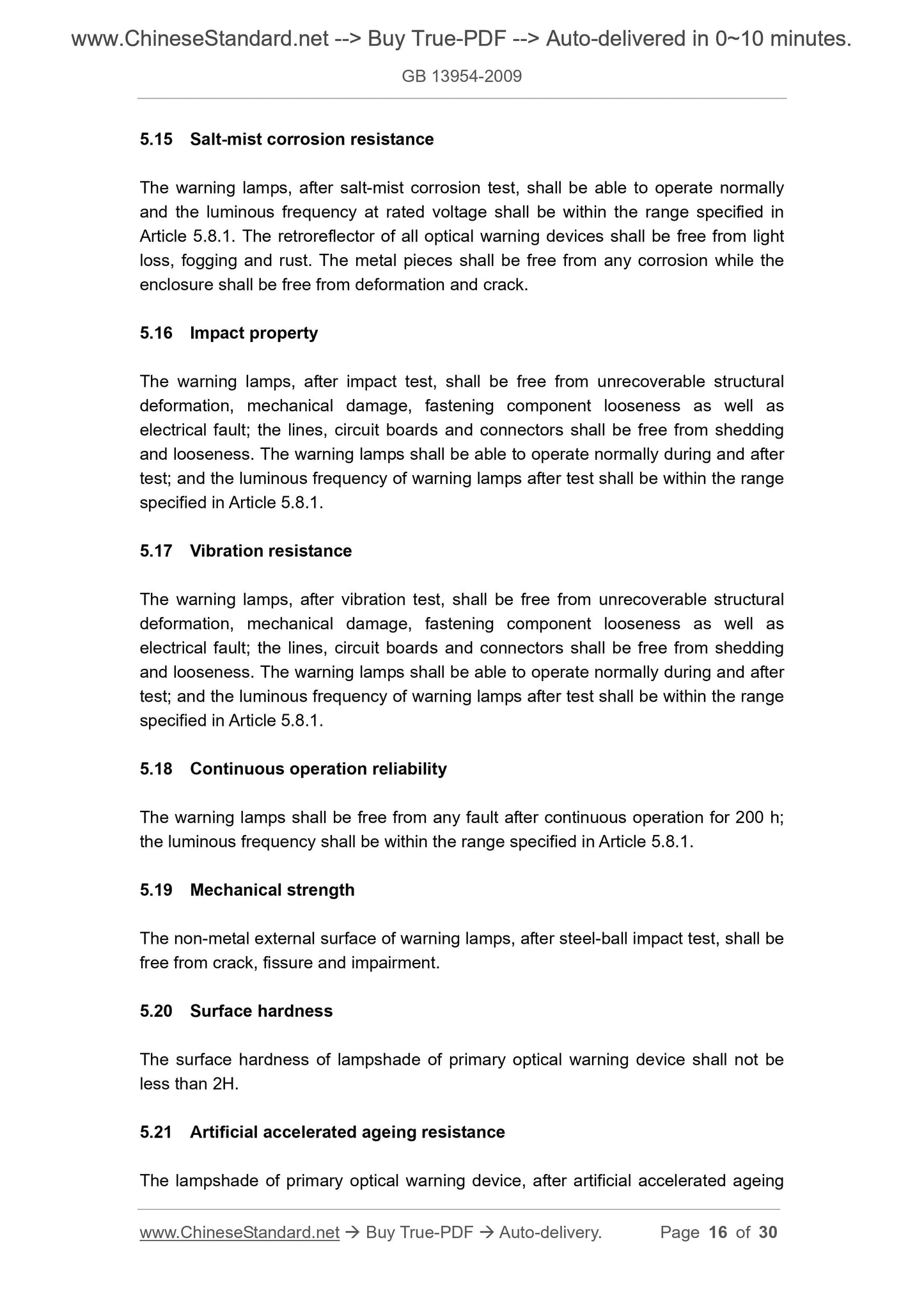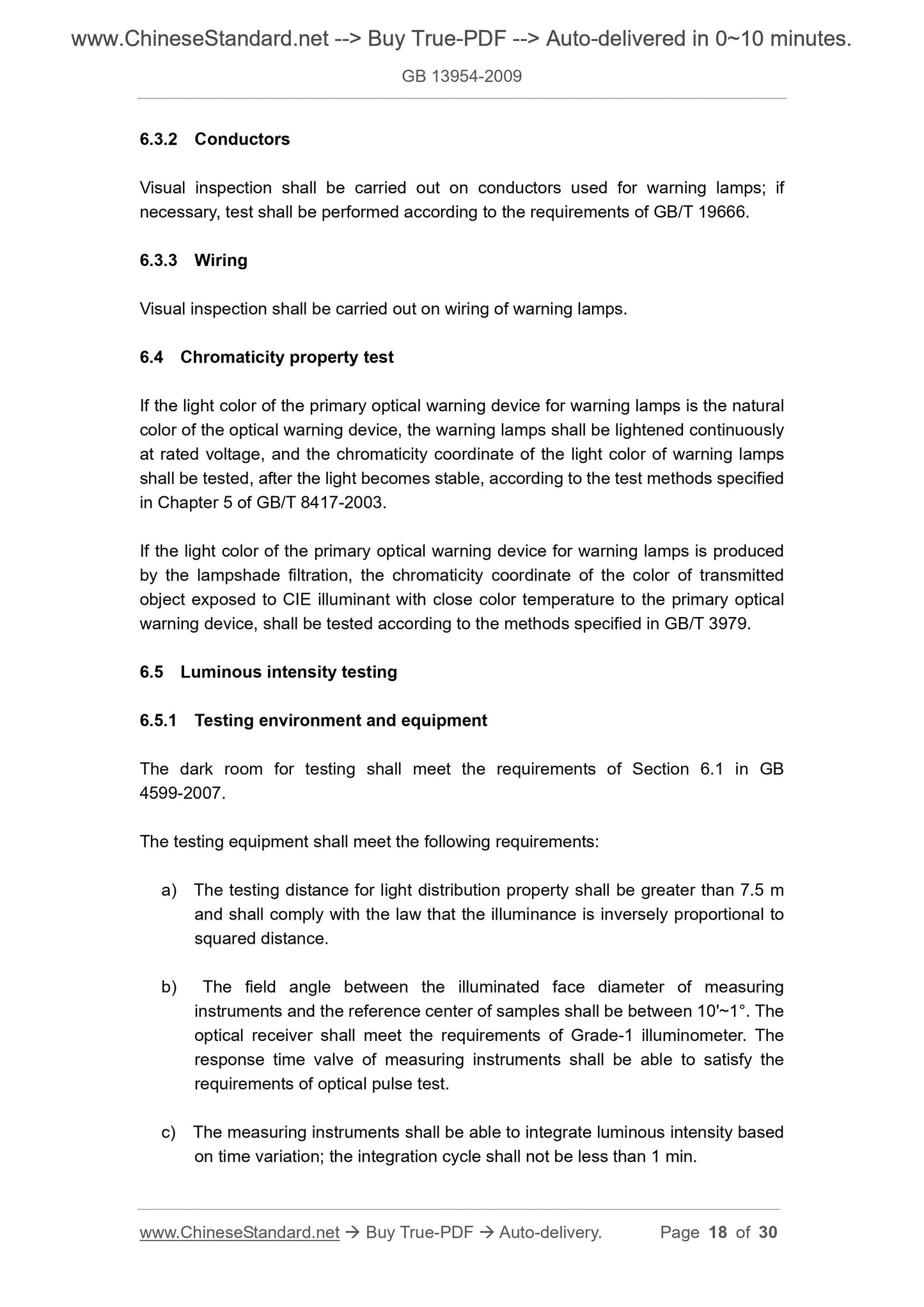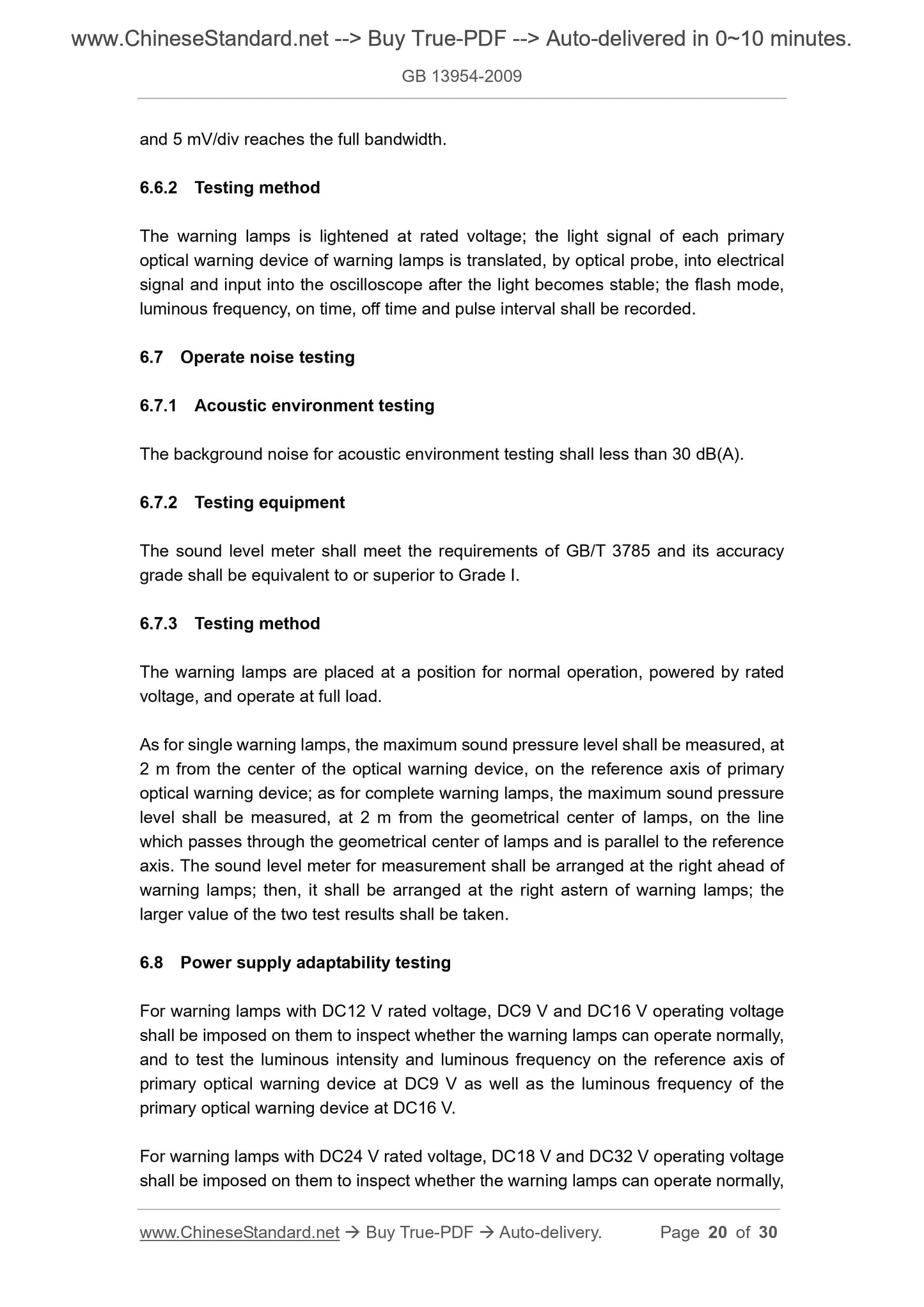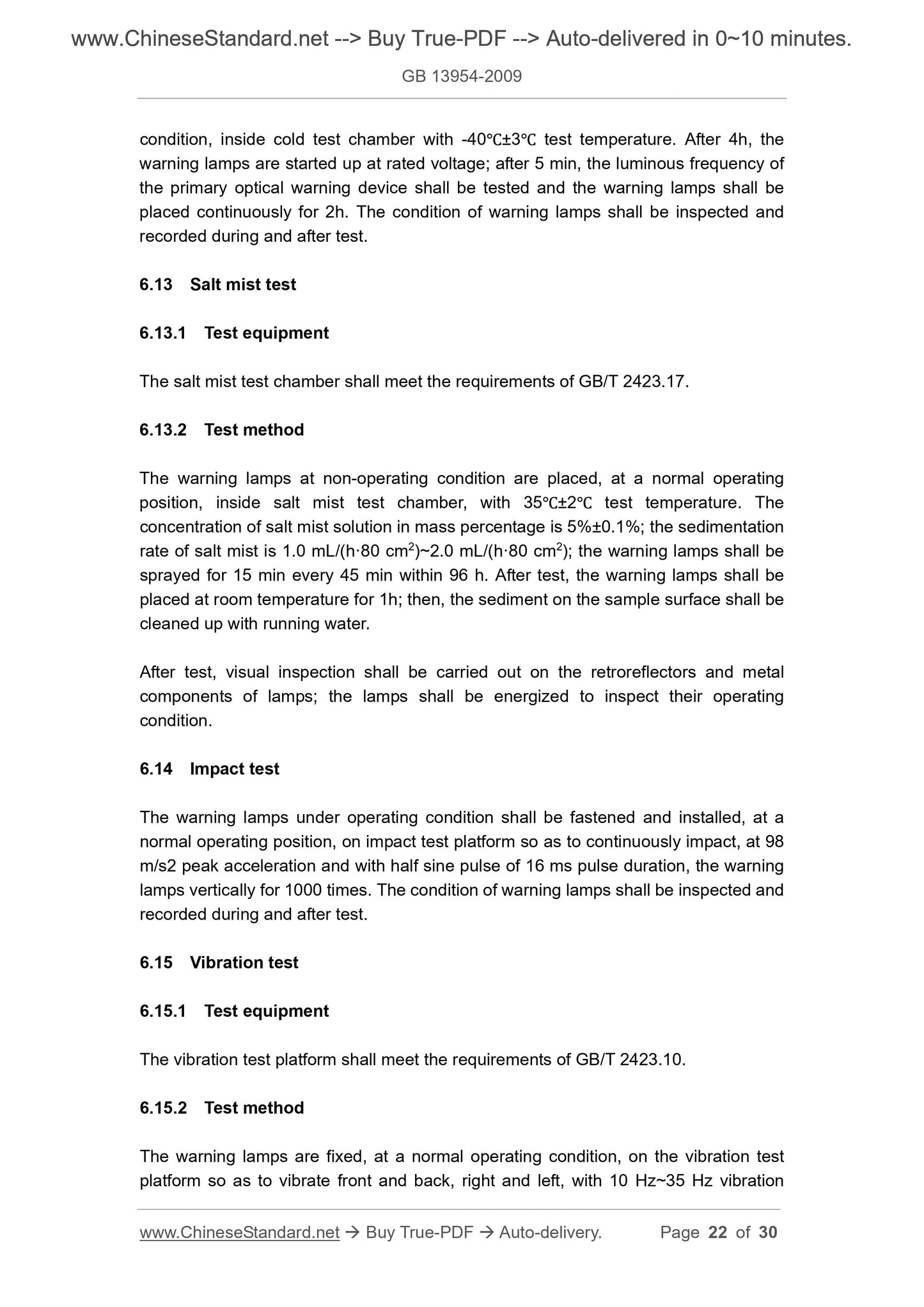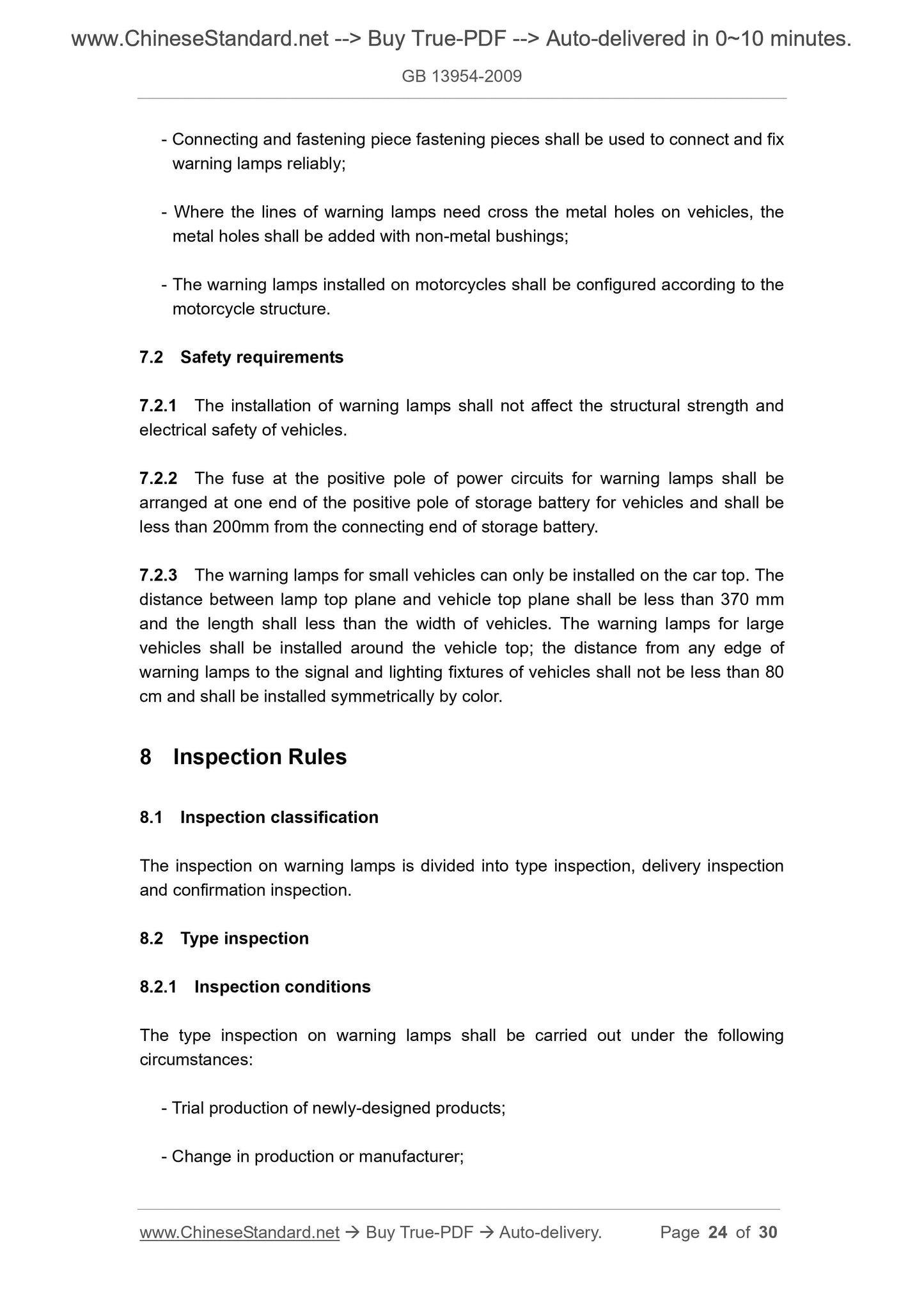PayPal, credit cards. Download editable-PDF & invoice in 1 second!
GB 13954-2009 English PDF (GB13954-2009)
GB 13954-2009 English PDF (GB13954-2009)
Precio habitual
$125.00 USD
Precio habitual
Precio de oferta
$125.00 USD
Precio unitario
/
por
Los gastos de envío se calculan en la pantalla de pago.
No se pudo cargar la disponibilidad de retiro
Delivery: 3 seconds. Download true-PDF + Invoice.
Get QUOTATION in 1-minute: Click GB 13954-2009
Historical versions: GB 13954-2009
Preview True-PDF (Reload/Scroll if blank)
GB 13954-2009: Warning lamps for police cars, fire engines, ambulances and engineering rescue vehicles
GB 13954-2009
NATIONAL STANDARD OF THE
PEOPLE’S REPUBLIC OF CHINA
ICS 13.310
A 90
Replacing GB 13954-2004
Warning Lamps for Police Cars, Fire Engines,
Ambulances and Engineering Rescue Vehicles
ISSUED ON: NOVEMBER 15, 2009
IMPLEMENTED ON: MAY 01, 2010
Issued by: General Administration of Quality Supervision, Inspection
and Quarantine;
Standardization Administration of the People's Republic of
China.
Table of Contents
Foreword ... 3
1 Scope ... 6
2 Normative References ... 6
3 Terms and Definitions ... 7
4 Classification Naming ... 10
5 Requirements ... 11
6 Test Methods ... 17
7 Installation ... 23
8 Inspection Rules ... 24
9 Markings, Conformity Certificates and Inspection Rules ... 26
Appendix A (Normative) Chromaticity Diagram for the Light Colors of
Warning Lamps ... 29
Bibliography ... 30
Warning Lamps for Police Cars, Fire Engines,
Ambulances and Engineering Rescue Vehicles
1 Scope
This standard specifies the terms and definitions, classification and naming,
requirements, test methods, installation, inspection rules, marking, conformity
certificates as well as packing of warning lamps for police cars, fire engines,
ambulances and engineering rescue vehicles (hereinafter referred to as "warning
lamps").
This standard is applicable to the warning lamps installed and used on police cars, fire
engines, ambulances and engineering rescue vehicles.
2 Normative References
The following normative documents contain provisions which, through reference in
this standard, constitute provisions of this standard. For dated reference, subsequent
amendments to, or revisions of, any of these publications do not apply. However, all
parties coming to an agreement according to this standard are encouraged to study
whether the latest editions of these documents are applicable. For undated
references, the latest edition of the normative document referred to applies.
GB/T 2423.1 Environmental Testing for Electric and Electronic Products - Part 2:
Test Methods - Tests B: Cold (GB/T 2423.1-2008, IEC 60068-2-1: 2007, IDT)
GB/T 2423.2 Environmental Testing for Electric and Electronic Products - Part 2:
Test methods - Tests B: Dry heat (GB/T 2423.2-2008, IEC 60068-2-2: 2007, IDT)
GB/T 2423.10 Environmental Testing for Electric and Electronic Products - Part 2:
Test Methods - Test Fc: Vibration (Sinusoidal) (GB/T 2423.10-2008, IEC 60068-2-6:
1995, IDT)
GB/T 2423.17 Environmental Testing for Electric and Electronic Products - Part 2:
Test Methods - Tests Ka: Salt Mist (GB/T 2423.17-2008, IEC 60068-2-11: 1981,
IDT)
GB/T 2828.1 Sampling Procedures for Inspection by Attributes - Part 1: Sampling
Schemes Indexed by Acceptance Quality Limit (AQL) for Lot-by-lot Inspection
Ambulances
Special vehicles used for site medical rescue and auxiliary site medical rescue by
emergency rescue and medical institutions as well as disease prevention and control
institutions to transfer and rescue patients, or treat emergency epidemic and
unexpected public health incidents.
3.4
Engineering rescue vehicles
Special vehicles and scene-commanding vehicles for flood prevention, water
conservancy, electric power, mine, urban construction, traffic and railway departments
to repair public utilities and rescue people's lives and properties.
3.5
Warning lamps
Lamps installed on police cars, fire engines, ambulances and engineering rescue
vehicles to send out warning, alerting, danger or emergency signals.
3.6
Reference axis
A line which passes through the geometrical center of primary optical warning device
and is parallel to the horizontal plane and vertical to the normal section of warning
lamps.
3.7
Symmetry axis
A line which passes the central symmetry point of optical warning device and is
parallel to the reference axis.
3.8
Primary optical warning device
Optical warning devices installed on the warning lamps to send out warning, alerting,
danger or emergency signals.
Optical power
Ie
The total optical power in a unit solid angle; unit: cdꞏs; its mathematical expression is
as follows:
00te IdtI
Where,
I -- instantaneous luminous intensity, cd;
t0 -- on time, s.
3.15
Single warning lamps
Cylindrical or square warning lamps with a single primary optical warning device.
3.16
Complete warning lamps
Warning lamps consisting of primary optical warning device and secondary optical
warning device, or primary optical warning device and illuminating light, or primary
optical warning device, secondary optical warning device and illuminating light.
4 Classification Naming
4.1 Classification
The warning lamps may be divided into warning lamps for police cars, fire engines,
ambulances and engineering rescue vehicles respectively according to their different
purposes.
4.2 Naming
The product model of warning lamps shall be named according to the following
structure and requirements:
5.3 Optical warning devices
5.3.1 Type of optical warning devices
The gas discharge lamp, light emitting diodes (LED) and filament lamps stated in GB
15766.1 may be adopted as optical warning devices of the warning lamps.
5.3.2 Luminous mode
The luminous modes of the primary optical warning device of warning lamps include
rotation, frequency-flash, pulse, frequency-change and multi-lamp circulation.
5.4 Letters and symbols
There shall be clear and standardized letters or symbols on or nearby switch and
press key to indicate their functions and on-off condition; the letters shall be in
Chinese; if necessary, other language may also be used. Where fuse is used, the
rated current of fuse shall be clearly indicated.
The above-mentioned letters and symbols shall be clear and durable.
5.5 Electrical property
5.5.1 Power supply
Rated voltage of power supply for warning lamps: DC12V or DC24V.
The warning lamps at rated voltage shall be able to withstand polar inverse-wiring test
for 1min. Except fuse, there shall be no other electrical fault.
If the opening and closing of warning lamps are controlled by soft switch; the standby
current of warning lamps shall be less than 5 mA.
5.5.2 Conductor
The conductors used for warning lamps shall be in accordance with the requirements
of GB/T 19666.
5.5.3 Wiring
The conductors inside warning lamps shall be provided with proper protection so as to
ensure these conductors don't contact the components which may cause any damage
on conductor insulation. Where the conductors need pass through metal holes, the
metal holes shall be chamfered and shall be free from any sharp edge; non-metal
The noise of warning lamps shall be less than 55 dB(A) when operating at full load
under rated voltage.
5.10 Power supply adaptability
For warning lamps with DC12 V rated voltage, the warning lamps shall be able to
operate normally where powered by DC9.0 V~DC16 V voltage, and the luminous
frequency shall be within the range specified in Article 5.8.1; where powered by
DC9.0V voltage, the luminous intensity on the reference axis of each primary optical
warning device for warning lamps shall not be less than 90% of those specified in
Section 5.7.
For warning lamps with DC24 V rated voltage, the warning lamps shall be able to
operate normally where powered by DC18 V~DC32 V voltage, and the luminous
frequency shall be within the range specified in Article 5.8.1; where powered by DC18
V voltage, the lum...
Get QUOTATION in 1-minute: Click GB 13954-2009
Historical versions: GB 13954-2009
Preview True-PDF (Reload/Scroll if blank)
GB 13954-2009: Warning lamps for police cars, fire engines, ambulances and engineering rescue vehicles
GB 13954-2009
NATIONAL STANDARD OF THE
PEOPLE’S REPUBLIC OF CHINA
ICS 13.310
A 90
Replacing GB 13954-2004
Warning Lamps for Police Cars, Fire Engines,
Ambulances and Engineering Rescue Vehicles
ISSUED ON: NOVEMBER 15, 2009
IMPLEMENTED ON: MAY 01, 2010
Issued by: General Administration of Quality Supervision, Inspection
and Quarantine;
Standardization Administration of the People's Republic of
China.
Table of Contents
Foreword ... 3
1 Scope ... 6
2 Normative References ... 6
3 Terms and Definitions ... 7
4 Classification Naming ... 10
5 Requirements ... 11
6 Test Methods ... 17
7 Installation ... 23
8 Inspection Rules ... 24
9 Markings, Conformity Certificates and Inspection Rules ... 26
Appendix A (Normative) Chromaticity Diagram for the Light Colors of
Warning Lamps ... 29
Bibliography ... 30
Warning Lamps for Police Cars, Fire Engines,
Ambulances and Engineering Rescue Vehicles
1 Scope
This standard specifies the terms and definitions, classification and naming,
requirements, test methods, installation, inspection rules, marking, conformity
certificates as well as packing of warning lamps for police cars, fire engines,
ambulances and engineering rescue vehicles (hereinafter referred to as "warning
lamps").
This standard is applicable to the warning lamps installed and used on police cars, fire
engines, ambulances and engineering rescue vehicles.
2 Normative References
The following normative documents contain provisions which, through reference in
this standard, constitute provisions of this standard. For dated reference, subsequent
amendments to, or revisions of, any of these publications do not apply. However, all
parties coming to an agreement according to this standard are encouraged to study
whether the latest editions of these documents are applicable. For undated
references, the latest edition of the normative document referred to applies.
GB/T 2423.1 Environmental Testing for Electric and Electronic Products - Part 2:
Test Methods - Tests B: Cold (GB/T 2423.1-2008, IEC 60068-2-1: 2007, IDT)
GB/T 2423.2 Environmental Testing for Electric and Electronic Products - Part 2:
Test methods - Tests B: Dry heat (GB/T 2423.2-2008, IEC 60068-2-2: 2007, IDT)
GB/T 2423.10 Environmental Testing for Electric and Electronic Products - Part 2:
Test Methods - Test Fc: Vibration (Sinusoidal) (GB/T 2423.10-2008, IEC 60068-2-6:
1995, IDT)
GB/T 2423.17 Environmental Testing for Electric and Electronic Products - Part 2:
Test Methods - Tests Ka: Salt Mist (GB/T 2423.17-2008, IEC 60068-2-11: 1981,
IDT)
GB/T 2828.1 Sampling Procedures for Inspection by Attributes - Part 1: Sampling
Schemes Indexed by Acceptance Quality Limit (AQL) for Lot-by-lot Inspection
Ambulances
Special vehicles used for site medical rescue and auxiliary site medical rescue by
emergency rescue and medical institutions as well as disease prevention and control
institutions to transfer and rescue patients, or treat emergency epidemic and
unexpected public health incidents.
3.4
Engineering rescue vehicles
Special vehicles and scene-commanding vehicles for flood prevention, water
conservancy, electric power, mine, urban construction, traffic and railway departments
to repair public utilities and rescue people's lives and properties.
3.5
Warning lamps
Lamps installed on police cars, fire engines, ambulances and engineering rescue
vehicles to send out warning, alerting, danger or emergency signals.
3.6
Reference axis
A line which passes through the geometrical center of primary optical warning device
and is parallel to the horizontal plane and vertical to the normal section of warning
lamps.
3.7
Symmetry axis
A line which passes the central symmetry point of optical warning device and is
parallel to the reference axis.
3.8
Primary optical warning device
Optical warning devices installed on the warning lamps to send out warning, alerting,
danger or emergency signals.
Optical power
Ie
The total optical power in a unit solid angle; unit: cdꞏs; its mathematical expression is
as follows:
00te IdtI
Where,
I -- instantaneous luminous intensity, cd;
t0 -- on time, s.
3.15
Single warning lamps
Cylindrical or square warning lamps with a single primary optical warning device.
3.16
Complete warning lamps
Warning lamps consisting of primary optical warning device and secondary optical
warning device, or primary optical warning device and illuminating light, or primary
optical warning device, secondary optical warning device and illuminating light.
4 Classification Naming
4.1 Classification
The warning lamps may be divided into warning lamps for police cars, fire engines,
ambulances and engineering rescue vehicles respectively according to their different
purposes.
4.2 Naming
The product model of warning lamps shall be named according to the following
structure and requirements:
5.3 Optical warning devices
5.3.1 Type of optical warning devices
The gas discharge lamp, light emitting diodes (LED) and filament lamps stated in GB
15766.1 may be adopted as optical warning devices of the warning lamps.
5.3.2 Luminous mode
The luminous modes of the primary optical warning device of warning lamps include
rotation, frequency-flash, pulse, frequency-change and multi-lamp circulation.
5.4 Letters and symbols
There shall be clear and standardized letters or symbols on or nearby switch and
press key to indicate their functions and on-off condition; the letters shall be in
Chinese; if necessary, other language may also be used. Where fuse is used, the
rated current of fuse shall be clearly indicated.
The above-mentioned letters and symbols shall be clear and durable.
5.5 Electrical property
5.5.1 Power supply
Rated voltage of power supply for warning lamps: DC12V or DC24V.
The warning lamps at rated voltage shall be able to withstand polar inverse-wiring test
for 1min. Except fuse, there shall be no other electrical fault.
If the opening and closing of warning lamps are controlled by soft switch; the standby
current of warning lamps shall be less than 5 mA.
5.5.2 Conductor
The conductors used for warning lamps shall be in accordance with the requirements
of GB/T 19666.
5.5.3 Wiring
The conductors inside warning lamps shall be provided with proper protection so as to
ensure these conductors don't contact the components which may cause any damage
on conductor insulation. Where the conductors need pass through metal holes, the
metal holes shall be chamfered and shall be free from any sharp edge; non-metal
The noise of warning lamps shall be less than 55 dB(A) when operating at full load
under rated voltage.
5.10 Power supply adaptability
For warning lamps with DC12 V rated voltage, the warning lamps shall be able to
operate normally where powered by DC9.0 V~DC16 V voltage, and the luminous
frequency shall be within the range specified in Article 5.8.1; where powered by
DC9.0V voltage, the luminous intensity on the reference axis of each primary optical
warning device for warning lamps shall not be less than 90% of those specified in
Section 5.7.
For warning lamps with DC24 V rated voltage, the warning lamps shall be able to
operate normally where powered by DC18 V~DC32 V voltage, and the luminous
frequency shall be within the range specified in Article 5.8.1; where powered by DC18
V voltage, the lum...
Share
